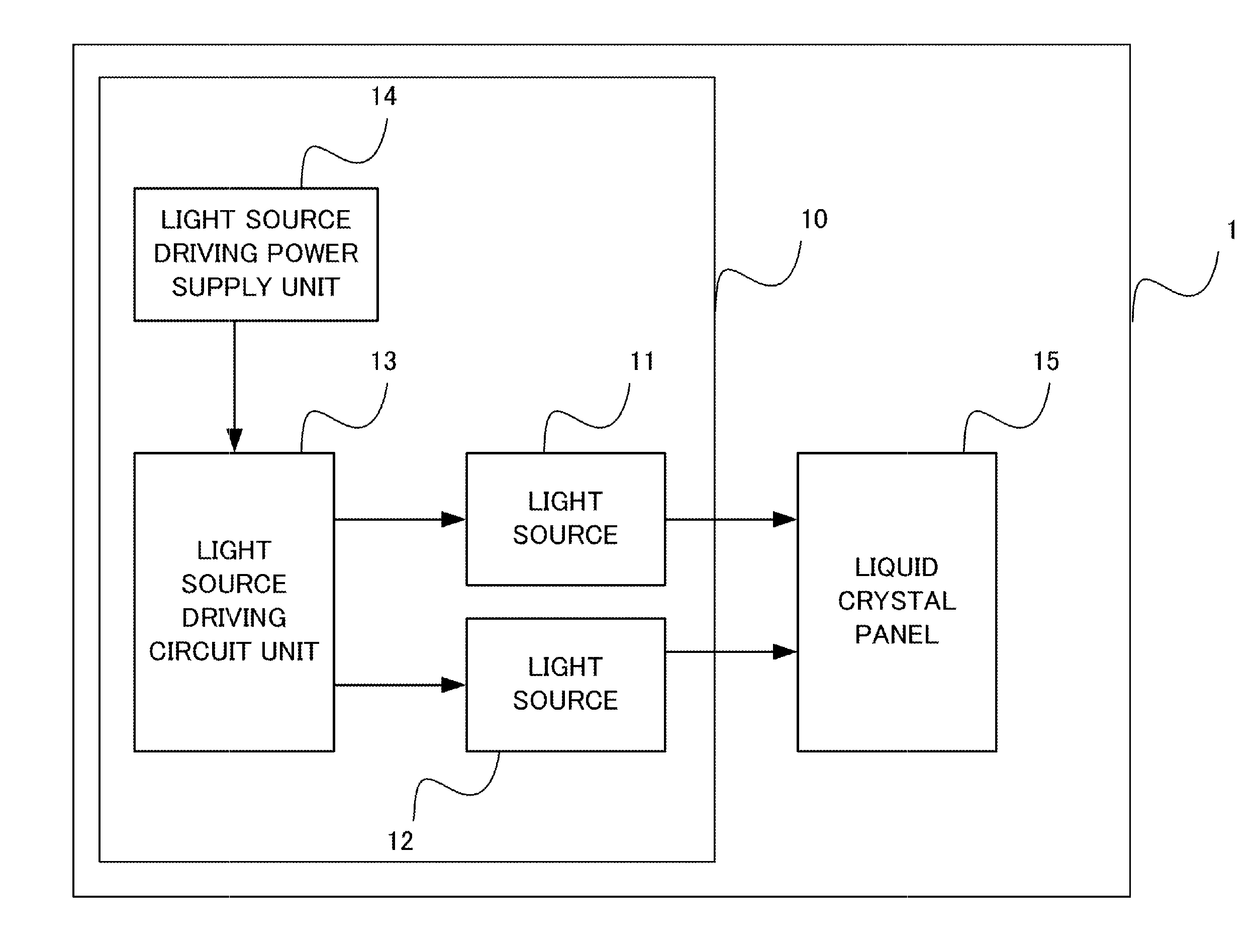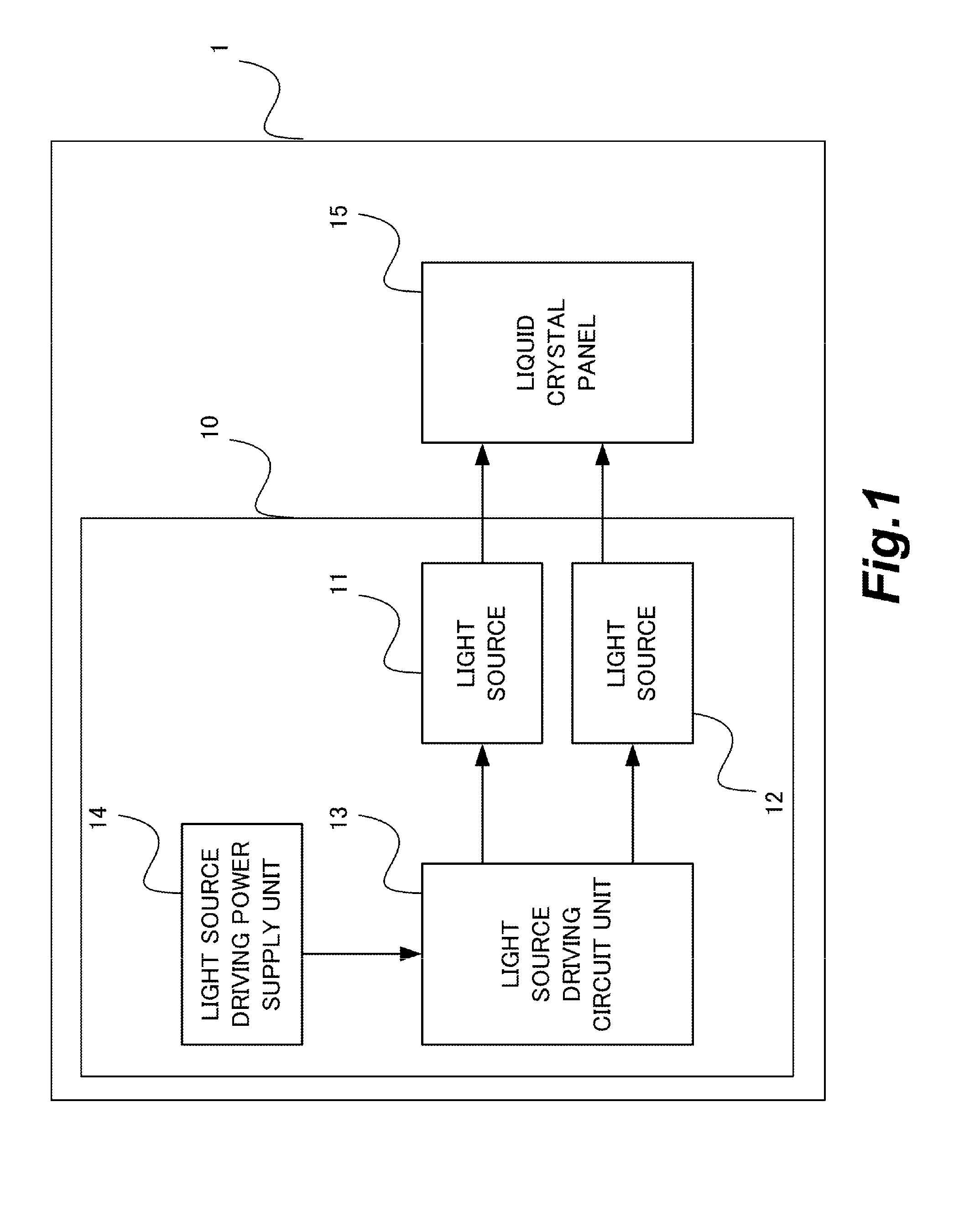Light emitting apparatus, backlight apparatus, and display apparatus
a backlight apparatus and light source technology, applied in the field of light emitting apparatus, backlight apparatus, and display apparatus, can solve the problems of complicated control circuit, inapplicability of backlights with a wide color gamut, and use of plurality of monochromatic light sources, so as to suppress individual differences in the manner of sensing colors, restrict the configuration of light source and control, and wide color gamut
- Summary
- Abstract
- Description
- Claims
- Application Information
AI Technical Summary
Benefits of technology
Problems solved by technology
Method used
Image
Examples
embodiment 1
[0029]Embodiments of the present invention will be described with reference to the drawings. Embodiment 1 is characterized by a backlight including two types of LEDs as light sources to emit white light, in which the spectral characteristic of the white light has peaks for red, green, and blue and in which the spectral characteristic of blue has a broad shape that is linearly symmetric about a peak wavelength. Hereinafter, specific examples of implementation methods are explained.
[0030]FIG. 1 is a block diagram depicting a general configuration of an image display apparatus according to Embodiment 1. An image display apparatus 1 has a backlight 10 and a liquid crystal panel 15. The backlight 10 has a light source 11 (first light source), a light source 12 (second light source), a light source driving circuit unit 13, and a light source driving power supply unit 14. Pixels in the liquid crystal panel 15 each have a blue color filter, a green color filter, and a red color filter. The ...
embodiment 2
[0042]FIG. 6 is a diagram depicting a spectral characteristic 20 of a light source 11 and a spectral characteristic 21 of a light source 12 in a backlight according to Embodiment 2 of the present invention.
[0043]Embodiment 2 is similar, in the configuration of the light sources, to but is different, in the spectral characteristic of each light source, from Embodiment 1. As depicted in FIG. 6, the light source 11 is a LED that emits ultraviolet light with a dominant wavelength within a predetermined fourth wavelength range. The LED excites blue light with a dominant wavelength within a first wavelength range. Furthermore, the light source 12 is a LED that emits blue light with a dominant wavelength within a second wavelength range. The LED excites green light with a peak within the second wavelength range and red light with a peak within the third wavelength range. The LED excites red light with a dominant wavelength within a third wavelength range.
[0044]In Embodiment 2, the light so...
embodiment 3
[0048]FIG. 8 is a diagram depicting a spectral characteristic 23 of a light source 11 and a spectral characteristic 24 of a light source 12 in a backlight according to Embodiment 3 of the present invention.
[0049]Embodiment 3 has a light source configuration similar to the light source configuration of Embodiment 1 but is different from Embodiment 1 in the spectral characteristic of each light source. As depicted in FIG. 8, the light source 11 is a LED that emits blue light with a dominant wavelength within a first wavelength range. The LED excites green light with a dominant wavelength within a second wavelength range and red light with a dominant wavelength within a third wavelength range. Furthermore, the light source 12 is a LED that emits blue light with a dominant wavelength within the first wavelength range.
[0050]In Embodiment 3, a peak wavelength within the first wavelength range of blue light emitted by the LED of the light source 11 is different from a peak wavelength withi...
PUM
| Property | Measurement | Unit |
|---|---|---|
| peak wavelength | aaaaa | aaaaa |
| wavelength range | aaaaa | aaaaa |
| wavelength range | aaaaa | aaaaa |
Abstract
Description
Claims
Application Information
 Login to View More
Login to View More - R&D
- Intellectual Property
- Life Sciences
- Materials
- Tech Scout
- Unparalleled Data Quality
- Higher Quality Content
- 60% Fewer Hallucinations
Browse by: Latest US Patents, China's latest patents, Technical Efficacy Thesaurus, Application Domain, Technology Topic, Popular Technical Reports.
© 2025 PatSnap. All rights reserved.Legal|Privacy policy|Modern Slavery Act Transparency Statement|Sitemap|About US| Contact US: help@patsnap.com



